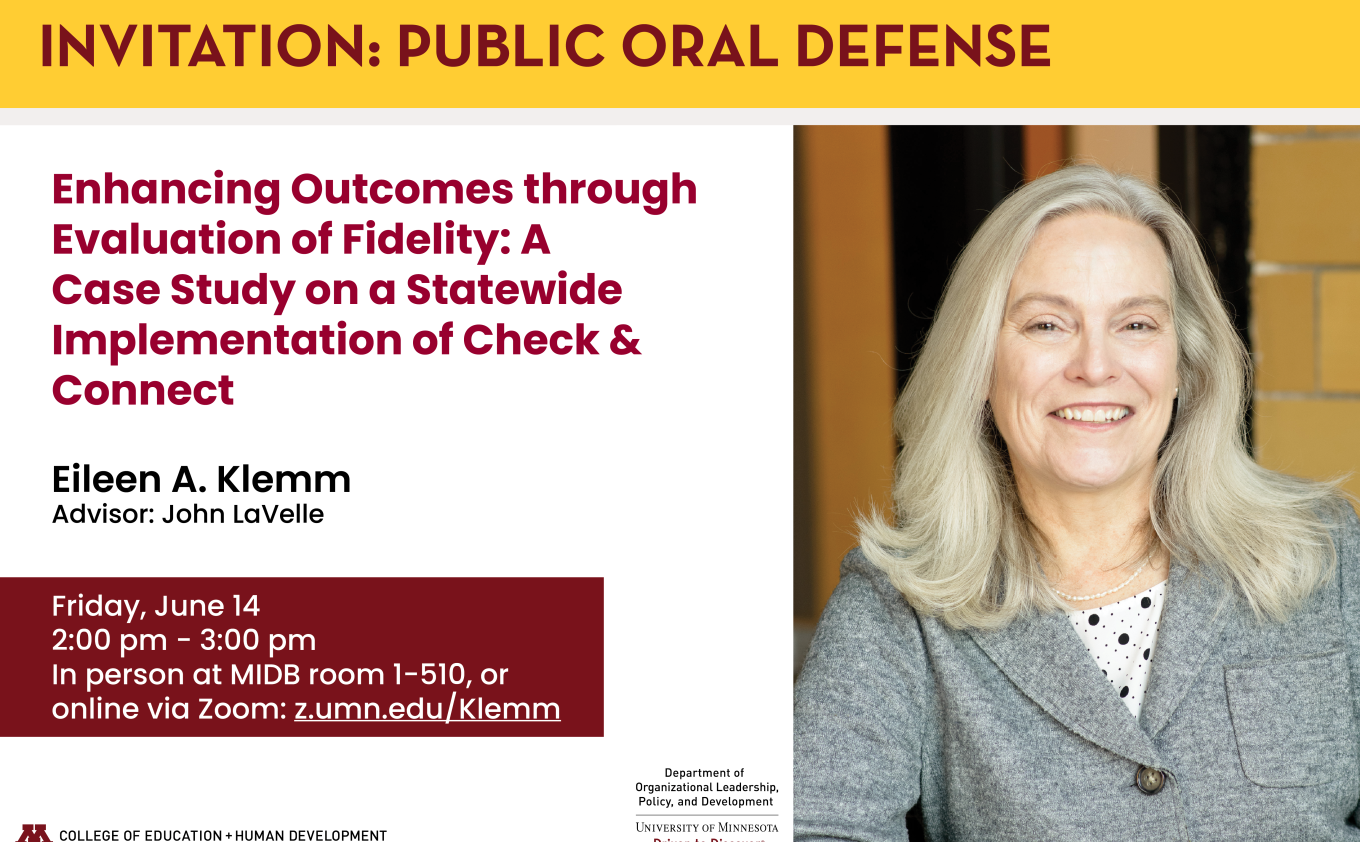Events
Public Oral Defense: Eileen A. Klemm

-
Hybrid
Enhancing Outcomes through Evaluation of Fidelity: A Case Study on a Statewide Implementation of Check & Connect
Advisor: John LaVelle
- In person at Masonic Institute for the Developing Brain Community Center Multi-Purpose Room (1-510) , 2025 East River Parkway, Minneapolis
- or Online via Zoom: z.umn.edu/Klemm
Abstract:
High school graduation is more than a milestone; it is a pivotal determinant of economic and social prosperity. Despite this importance, many students still struggle to achieve this significant accomplishment. Although graduation rates have improved over the past decade, according to the National Center for Education Statistics, the national adjusted cohort graduation rate (ACGR) in 2020 was 87% overall, however, students with disabilities had an even lower ACGR of 71% (Irwin et al., 2023). To address this issue, evidence-based dropout prevention programs like Check & Connect have been developed. However, these programs can only be effective if their core components are implemented as designed. Ensuring fidelity to the program’s design and implementation is critical to achieving positive outcomes, such as decreased dropout rates. Evaluation, a key tool for assessing the fidelity of program implementation, is designed to provide a comprehensive and accurate understanding of the program's effectiveness, instilling confidence in the process and its potential to improve student outcomes.
This study aimed to understand how evaluation procedures are integrated into the implementation process and how these procedures benefit program staff and students. It explored the statewide implementation of Check & Connect, focusing on how the state-level implementation team utilized fidelity tools and strategies and incorporated evaluation procedures. A case study design was employed, using primarily qualitative methodologies such as comprehensive document reviews, existing data analysis, interviews with state-level team members, and focus groups with school-level Check & Connect coordinators. The study specifically examined the evaluation procedures developed by the state-level team and carried out at the district and school levels.
The study’s analysis revealed several salient themes related to the evaluation of Check & Connect implementation at the school and state levels, including (a) developing and selecting effective fidelity tools with stakeholder input, (b) understanding the purpose of evaluation procedures and fidelity tools at all levels, (c) the critical role of personnel in the evaluation process, and (d) the recognition that full implementation requires time. The development of fidelity tools involved significant stakeholder input to ensure their effectiveness and relevance. Successful implementation depended on mentors and coordinators being familiar with and understanding the tools’ purposes and consistently applying them. At the school level, Check & Connect implementation relied heavily on coordinators to maintain and enhance program fidelity. The data suggest that implementing educational programs like Check & Connect with full fidelity is a process that requires patience and sustained effort.
Photographs taken at the event may be used in University of Minnesota print and online publications, promotions, or shared with the CEHD community.
The University of Minnesota shall provide equal access to and opportunity in its programs, facilities, and employment without regard to race, color, creed, religion, national origin, gender, age, marital status, familial status, disability, public assistance status, membership or activity in a local commission created for the purpose of dealing with discrimination, veteran status, sexual orientation, gender identity, or gender expression. All are welcome.
The University of Minnesota campuses were built on the traditional homelands of the Dakota and Ojibwe, and scores of other Indigenous peoples who have walked on these lands from time immemorial. It is important to acknowledge the peoples on whose land we live, learn, and work as we seek to improve and strengthen our relations with our tribal nations. We also acknowledge that words are not enough. We must ensure that our institution provides support, resources, and programs that increase access to all aspects of higher education for our American Indian students, staff, faculty, and community members.